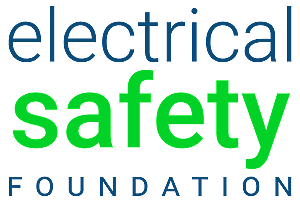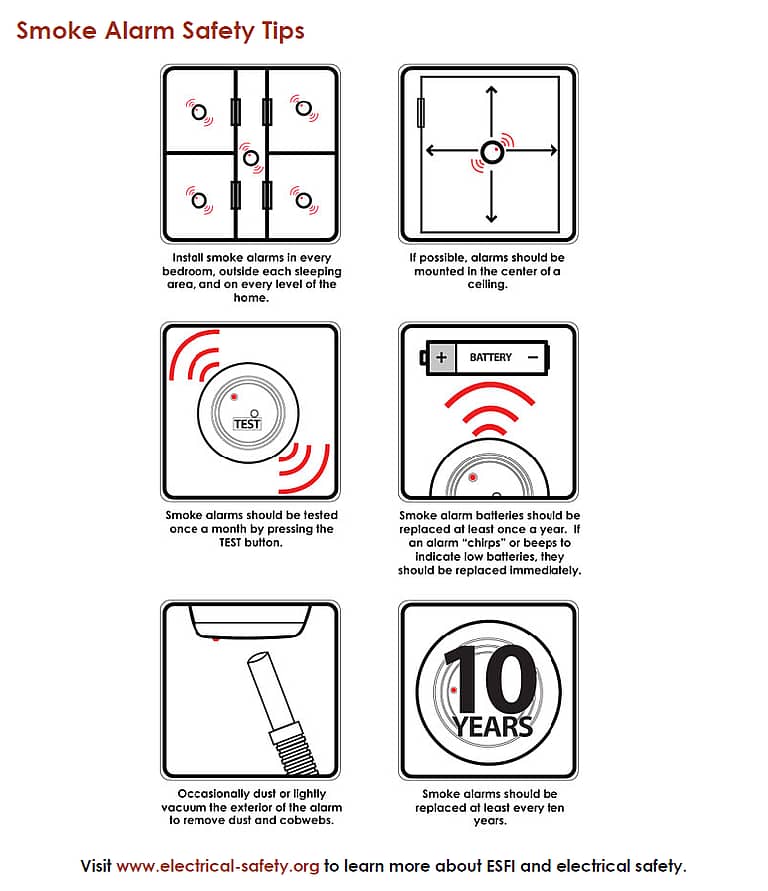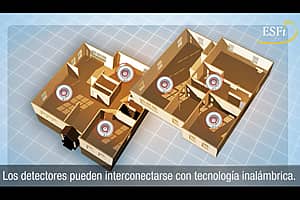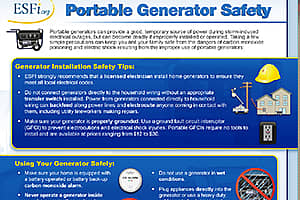Smoke Alarms
On average, 8 people die in a home fire each day in the U.S.—almost 3,000 people every year. While working smoke alarms cut the chance of dying in a fire nearly in half, roughly two-thirds of all home fire deaths occur in homes without working smoke alarms, according to statistics from the National Fire Protection Association (NFPA).
Newer smoke alarm recommendations and technologies now provide greater levels of home fire protection than ever before. Unfortunately, many people are unaware of these advances and lack the recommended level of residential smoke alarm protection as a result. Their homes may not be equipped with the appropriate number of alarms, or they may be relying on outdated or nonfunctional devices.
ESFI offers the following tips for making sure smoke alarms are installed and working properly:
Installation Tips
- Smoke alarms should be installed in every bedroom, outside each sleeping area, and on every level of the home.
- For the best protection, smoke alarms should be interconnected, so that they all sound if one sounds. Manufacturers are now producing battery operated alarms that are interconnected by wireless technology.
- Combination smoke alarms that include both ionization and photoelectric alarms offer the most comprehensive protection. An ionization alarm is more responsive to flames, while a photoelectric alarm is more responsive to a smoldering fire.
- Hardwired smoke alarms with battery backups are considered to be more reliable than those operated solely by batteries.
- Purchase smoke alarms from a reputable retailer that you trust.
- Choose alarms that bear the label of a nationally-recognized testing laboratory.
- Install smoke alarms at least 10 feet from cooking appliances to reduce the possibility of nuisance alarms.
- Alarms installed between 10-20 feet of a cooking appliance must have a hush feature to temporarily reduce the alarm sensitivity or must be a photoelectric alarm.
- If possible, alarms should be mounted in the center of a ceiling. If mounted on a wall, they should be located 6 to 12 inches below the ceiling.
- Avoid locating alarms near bathrooms, heating appliances, windows or ceiling fans.
Maintenance Tips
- Smoke alarms should be tested once a month by pressing the TEST button.
- Smoke alarm batteries should be replaced in accordance with the manufacturer’s instructions, at least once a year. If an alarm “chirps” or “beeps” to indicate low batteries, they should be replaced immediately.
- Occasionally dust or lightly vacuum the exterior of the alarm to remove dust and cobwebs.
- Smoke alarms should be replaced in accordance with the manufacturer’s instructions, at least every ten years.
- Never paint over a smoke alarm.
More information about smoke alarms is available in Smoke Alarm Maintenance Calendar, Smoke Alarm Safety Tips for Older Adults, and the Fire Safety Planning Checklist, or by viewing the Smoke Alarm Safety Virtual Demonstration (also available in Spanish).
Carbon Monoxide Alarms
Every year, over 200 people in the United States die from carbon monoxide (CO) poisoning. Several thousand more are treated in hospital emergency rooms for treatment for CO poisoning.
Carbon monoxide (CO) is a poisonous gas that is created when common fuels such as natural gas, oil, wood or coal burn incompletely. This odorless, colorless, tasteless gas is often called the “silent killer” because it is virtually undetectable without the use of detection technology like a CO alarm.
More information about carbon monoxide can be found on the Carbon Monoxide Alarm Fact Sheet.
ESFI’s Carbon Monoxide Alarm Safety Tips sheet provides tips for the proper installation, maintenance and response to carbon monoxide alarms.
Many carbon monoxide poisonings are associated with the use of portable generators, be sure to visit ESFI’s Portable Generator page for important safety tips before you purchase or use one.
Fire Escape Planning
Working smoke alarms can mean the difference between life and death in the event of a home fire, but there is more you need to do to ensure your family is prepared to safely escape from a fire emergency. Once the smoke alarm sounds, you may have only a few minutes to get out. Prepare a fire escape plan for your family before an emergency happens.
The following tips will help you develop a safe and effective family fire escape plan:
- Everyone in your family, including children, should be involved in creating your fire escape plan.
- Make sure everyone in your home knows what the fire alarm sounds like and what it means.
- Walk through your home and note any possible exits, including windows. Draw a floor plan of your house and mark two ways to escape from each room. Make sure that doors and windows leading to the outside can be opened easily by everyone in the family.
- Establish a meeting place a safe distance outside your home where your family will gather after escaping. The meeting place should be something permanent and easy to identify, such as a tree, light pole, or mailbox, and should be a place where firefighters will easily see you.
- Teach everyone in the family to call 911 from a neighbor’s home or cellular phone once they have safely gotten outside.
- Practice your escape plan by having at least two fire drills every year. One of your drills should occur during the night when your family members are sleeping.







